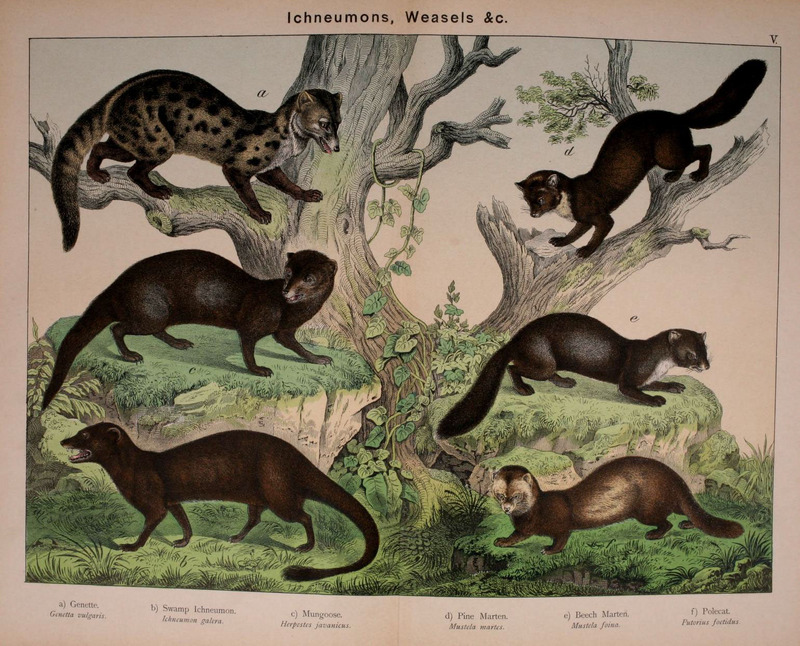|
| Query: weasel | Result: 139th of 242 | |
common genet (Genetta genetta), fossa (Cryptoprocta ferox), small Asian mongoose (Herpestes javanicus), European pine marten (Martes martes), beech marten (Martes foina), European polecat (Mustela putorius)
| Subject: | common genet (Genetta genetta), fossa (Cryptoprocta ferox), small Asian mongoose (Herpestes javanicus), European pine marten (Martes martes), beech marten (Martes foina), European polecat (Mustela putorius)
| | Poster: | Wiki Photos (---@---.---)
| |

| Resolution: 1540x1243
File Size: 484618 Bytes
Date: 2011:07:25 13:22:14
Upload Date: 2017:07:22 02:55:19
|
Ichneumons, Weasels &c.
a) Genette. Genetta vulgaris. = common genet (Genetta genetta)
b) Swamp Ichneumon. Ichneumon galera. = fossa (Cryptoprocta ferox)
c) Mungoose. Herpestes javanicus. = small Asian mongoose (Herpestes javanicus)
d) Pine Marten. Mustela martes. = European pine marten (Martes martes)
e) Beech Marten. Mustela foina. = beech marten (Martes foina)
f) Polecat. Putorius foetidus. = European polecat (Mustela putorius)
Date 1889
BHL Page URL http://www.biodiversitylibrary.org/page/28687142
Author W. F. Kirby; Gotthilf Heinrich von Schubert; Society for Promoting Christian Knowledge (Great Britain).
Full title Natural history of the animal kingdom for the use of young people : in three parts, comprising I. Mammalia : II. Birds : Part III. Reptiles, amphibia, fishes, insects, worms, molluscs, zoophytes, &c. : with 91 coloured plates, including about 850 figures, and numerous additional illustrations in the text /
Source: https://commons.wikimedia.org/wiki/File:Natural_history_of_the_animal_kingdom_for_the_use_of_young_people_(Plate_V)_(5974928646).jpg
a) Genette. Genetta vulgaris. = common genet (Genetta genetta)
The common genet (Genetta genetta) is a small viverrid indigenous to Africa. It is widely distributed north of the Sahara, in savanna zones south of the Sahara to southern Africa and along the coast of Arabia, Yemen and Oman.
b) Swamp Ichneumon. Ichneumon galera. = fossa (Cryptoprocta ferox)
The fossa (Cryptoprocta ferox) is a cat-like, carnivorous mammal endemic to Madagascar. It is a member of the Eupleridae, a family of carnivorans closely related to the mongoose family (Herpestidae).
c) Mungoose. Herpestes javanicus. = small Asian mongoose (Herpestes javanicus)
The small Asian mongoose (Herpestes javanicus) is a species of mongoose found in the wild in South and Southeast Asia.
d) Pine Marten. Mustela martes. = European pine marten (Martes martes)
The European pine marten (Martes martes), known most commonly as the pine marten in Anglophone Europe, and less commonly also known as pineten, baum marten, or sweet marten, is an animal native to Northern Europe belonging to the mustelid family.
e) Beech Marten. Mustela foina. = beech marten (Martes foina)
The beech marten (Martes foina), also known as the stone marten, house marten or white breasted marten, is a species of marten native to much of Europe and Central Asia, though it has established a feral population in North America.
f) Polecat. Putorius foetidus. = European polecat (Mustela putorius)
The European polecat (Mustela putorius) — also known as the black or forest polecat, or fitch (as well as some other names) — is a species of mustelid native to western Eurasia and North Africa. |
^o^
Animal Pictures Archive for smart phones
^o^
|
|

